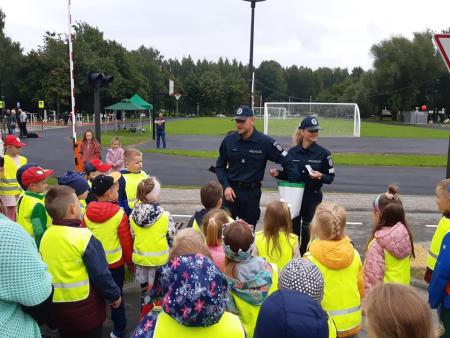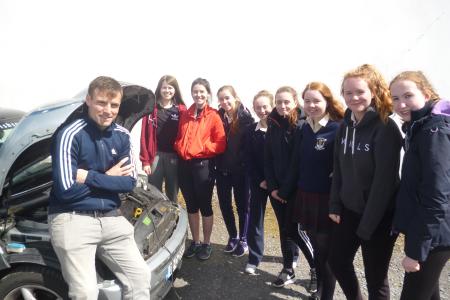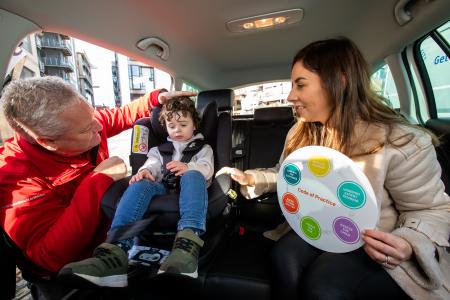Our members are dedicated to improving road safety and sharing their knowledge with the wider community. Here, you can explore our members' good practices – initiatives that have been assessed for their effectiveness in addressing a road safety problem and have proven results.
Get inspired – and sign up to share your good practices too!

Sunday, June 5, 2022
In 2008, several fatal accidents involving teenagers on bicycles occurred in our region. Parents' associations of secondary schools sat down around the table to think about a solution together. Studies showed that young people are very often involved in bicycle accidents. The cause is often “not being seen” in the dark. Most primary school children are required to wear a fluorescent jacket in our region. Young people in secondary school don't like wearing fluorescent jackets. They are laughed at by their schoolmates. Imposing an obligation is not possible.
XIU (volunteers organisation) looked for other solutions to tackle this problem in a way that would make it easier for them to do so.
XIU (volunteers organisation) looked for other solutions to tackle this problem in a way that would make it easier for them to do so.

Saturday, June 4, 2022
Vaikai kiekvieną dieną susiduria su eismu keliuose. Deja, eismo nelaimių, kuriose nukenčia vaikai, nepavyksta išvengti. Eismo saugumo įgūdžių ugdymas ikimokykliniame, ankstyvajame mokykliniame ir vyresniame amžiuje neišvengiama būtinybė. Tačiau eismo įgūdžiai nesuformuojami per vieną dieną. Mokyklos tikslas - ugdyti vaikų saugaus elgesio kelyje sampratą ir įgūdžius. Padėti vaikui įgyti jo amžių ir patirtį atitinkančias saugaus elgesio kelyje žinias bei ugdyti nuostatą būti atsakingiems už savo elgesį, veiksmus ir pasekmes kelyje. Mokykloje vykdomi edukaciniai užsiėmimai, renginiai, projektai, dviratininkų stovyklos, neformalaus ugdymo popamokiniai užsiėmimai bei akcijos saugaus eismo tema. Vaikai, šiandieną būdami atsakingi pėstieji ir keleiviai, ateityje taps rūpestingais ir kultūringais vairuotojais. Mokyklos veiklos rezultatas mažėjantis žuvusiųjų ir sužeistų vaikų skaičius Kauno mieste.

Friday, June 3, 2022
Road authorities are increasingly looking for effective road safety measures driven by data in order to succeed in the Vision Zero strategy which has been published by authorities in the national ‘Strategic plan road safety 2030’.
Driving behaviour data provides an important indicator of risk of accidents and road safety. This kind of data is very helpful to analyse how drivers behave and interact with the road infrastructure. For example: where does extreme driver behaviour occur frequently? For example frequent harsh braking on a specific road section can be the consequence of the road infrastructure. Driving behaviour data supports monitoring in an effective way. It enables authorities to check how road safety measures by improving infrastructure are affected driving behaviour.
Driving behaviour data provides an important indicator of risk of accidents and road safety. This kind of data is very helpful to analyse how drivers behave and interact with the road infrastructure. For example: where does extreme driver behaviour occur frequently? For example frequent harsh braking on a specific road section can be the consequence of the road infrastructure. Driving behaviour data supports monitoring in an effective way. It enables authorities to check how road safety measures by improving infrastructure are affected driving behaviour.

Friday, June 3, 2022
Road safety: deaths on Irish roads are increasing year on year , the last three years have shown trends of increasing from 2021- 130 fatalities. 2022- 155 fatalities,to a current high of 88 deaths this year, which is already 10 more death on this time last year, we aim to educate young people on responsibility of driving to the next generation of drivers respecting all road users, ensuring they are fully informed of all topics associated with driving. In our, triangulated program.
This fully supports the Road Safety Authority, who have outlined several priorities in their 2021-2030 phase of vision zero, to reduce the number of deaths by 50% includes key areas,
Seatbelts ,Speeding,Driving while impaired drugs and alcohol tests and penalties , Campaigns, Older pedestrians, E scooters, Time to talk, Anti speeding, Cycling, Vision zero, J1 campaign. Speed Fallacy, Safe vehicles.
We address these targets in our modules.
This fully supports the Road Safety Authority, who have outlined several priorities in their 2021-2030 phase of vision zero, to reduce the number of deaths by 50% includes key areas,
Seatbelts ,Speeding,Driving while impaired drugs and alcohol tests and penalties , Campaigns, Older pedestrians, E scooters, Time to talk, Anti speeding, Cycling, Vision zero, J1 campaign. Speed Fallacy, Safe vehicles.
We address these targets in our modules.

Friday, June 3, 2022
The Road Safety Authority child car seat checking service - Check it Fits was launched on a national, full-time basis in 2013. Since then, the service has grown in popularity and trust among the public, and as a result, has checked over 50,000 child car seats and visited over 1,100 locations all over Ireland.
In a study carried out by the RSA in 2016, of over 5,000 car seat checks, performed at the RSA Check it Fits service, it was found that as many as 4 out of 5 (80%) child car seats were incorrectly fitted.
Seat adjustments, carried out by the checker at the Check it Fits service, are categorised by severity. In the same study in 2016, it was found that of the seats that were incorrectly fitted, just over 80% were classified as a 'Major' adjustment eg the fitting being excessively loose to make it almost ineffective in the event of a crash or harsh braking.
The rest were classified as either a 'Minor' adjustment, 'Incompatible' (with child or car), 'Condemned' (not fit for purpose). Although some adjustments were classified as Minor (eg twisted seatbelt), even minor adjustments can make a big difference in how effectively the child is protected in the event of a crash.
The challenge was that we urgently needed to reduce this worrying trend, to protect children on our roads and to ensure they were travelling safely. Because we have new parents joining our target audience every day, perhaps with little or no reliable information, we decided to focus our efforts on reducing the level of 'Major' adjustments we were finding. We knew that the overall statistic of misuse would naturally reduce as a result but we needed to focus on the adjustment classifications to start with.
With this in mind, we had to develop a strategy that would inform and educate parents on child safety in cars from the very beginning of their journey through child car seat usage, from before their child is even born, until that child reaches 150cm and 36kg.
In a study carried out by the RSA in 2016, of over 5,000 car seat checks, performed at the RSA Check it Fits service, it was found that as many as 4 out of 5 (80%) child car seats were incorrectly fitted.
Seat adjustments, carried out by the checker at the Check it Fits service, are categorised by severity. In the same study in 2016, it was found that of the seats that were incorrectly fitted, just over 80% were classified as a 'Major' adjustment eg the fitting being excessively loose to make it almost ineffective in the event of a crash or harsh braking.
The rest were classified as either a 'Minor' adjustment, 'Incompatible' (with child or car), 'Condemned' (not fit for purpose). Although some adjustments were classified as Minor (eg twisted seatbelt), even minor adjustments can make a big difference in how effectively the child is protected in the event of a crash.
The challenge was that we urgently needed to reduce this worrying trend, to protect children on our roads and to ensure they were travelling safely. Because we have new parents joining our target audience every day, perhaps with little or no reliable information, we decided to focus our efforts on reducing the level of 'Major' adjustments we were finding. We knew that the overall statistic of misuse would naturally reduce as a result but we needed to focus on the adjustment classifications to start with.
With this in mind, we had to develop a strategy that would inform and educate parents on child safety in cars from the very beginning of their journey through child car seat usage, from before their child is even born, until that child reaches 150cm and 36kg.